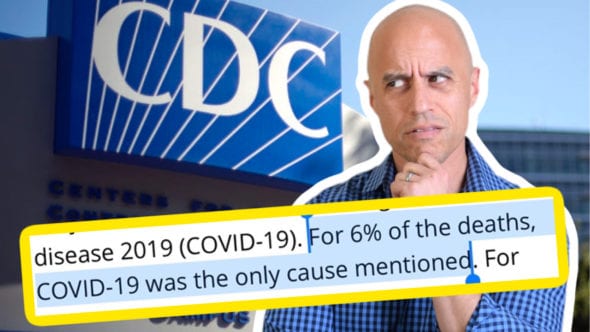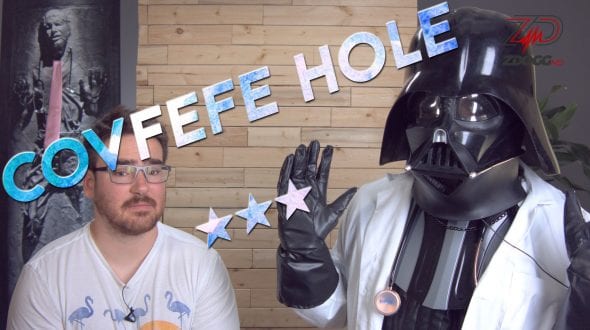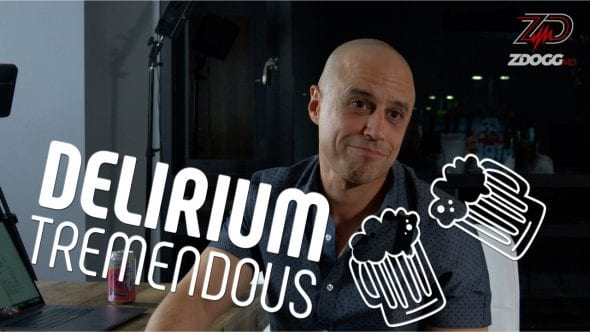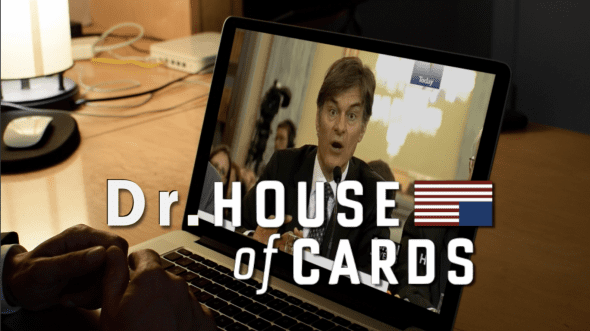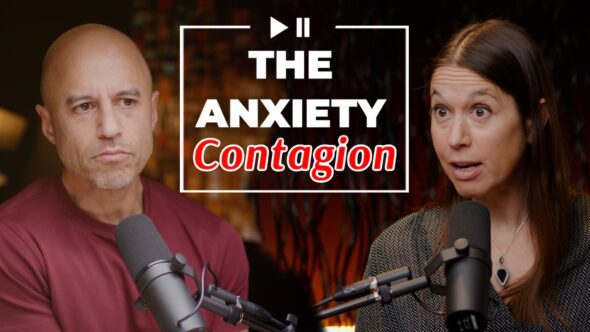Here’s how we can understand a potential connection between COVID mRNA vaccines and heart inflammation, or myocarditis.
– [Dr. Z] All right, what’s the deal with this myocarditis everyone’s talking about, in relation to the vaccine, particularly in young people, especially boys, especially after the second dose? It’s all over the news, FDA advisory, vaccine advisory committee is meeting on Friday, I think, to figure out what’s going on here. Let’s talk about it. Okay, first of all, what is myocarditis? So myocarditis is simply a fancy Latin way of saying inflammation of the heart muscle. Now, it’s not just myocarditis. There’s a phenomenon called pericarditis, which is inflammation of the lining around the heart, and so sometimes you can actually get a combination condition called myopericarditis.
They just try to make it as complicated as possible. So what is the inflammation? It’s really often an immune response, where these inflammatory cells come and cause inflammation within the heart muscle or the lining around the heart, and what that can do is it can cause dysfunction in the heart muscle, it can cause pain, irritation, abnormalities in the electrical conduction of the heart, and what you might see in terms of symptoms with myocarditis is people often will complain of a chest discomfort, either palpitations, so the sense that the heart is skipping a beat, or it feels like it’s beating in your neck or in your chest or it’s going fast or slow, or something’s not quite right, or pain, discomfort, where it is like a chest pain, like you might even expect someone who’s having a heart attack might have a similar type of chest pain.
There’s a very specific type of chest pain that sometimes happens with pericarditis, where it’s worse when you lean forward, because that puts a little more pressure on the sack around the heart and can cause this rubbing, and in fact, with your stethoscope, you can actually hear, sometimes, something called a pericardial friction rub from the heart beating within the sack around it and the inflammation causing a friction, and it can be worse with deep breaths, so they call it pleuritic, meaning you take a breath and it gets worse. (Error correction: pericarditis pain IMPROVES with leaning forward, not the other way around. Sorry for the confusion, I blame Fauci 😂 Sometimes I wonder if I have mental dyslexia 😭 ) So this kind of chest pain, the palpitations, shortness of breath can sometimes happen, and that can be caused by fluid that backs up a little bit into the pulmonary vessels, the vessels of the lungs, which can leak into the lung system and cause trouble with gas exchange.
That’s called pulmonary edema, and that can happen, because the heart’s not as efficient when it’s all inflamed at pumping blood forward, so some of it tends to back up. That explains another symptom people can complain of which is lower extremity swelling, called edema, peripheral edema, so like you push in on your ankle and it leaves a little pit there. So those are the biggest things, but of course, people can have other symptoms as well, lightheadedness, that sort of thing, and even more symptoms.
So those are the main things, and it all comes down to the fact that this heart muscle’s inflamed. Now, why is it inflamed? Well, the most common cause, actually, of myocarditis is viral infection or post viral infection, meaning you’ve been infected, and then later, the immune response, through unclear mechanisms, causes this inflammation of the cardiac muscle, and so viral myocarditis is not entirely uncommon.
It’s not extremely rare, it’s not super common, but it happens in a reasonable number of people per year. So there’s that background rate of myocarditis. It happens a lot of times in young people after a viral infection, a gastroenteritis, a stomach flu, something like that, and there’s a bunch of different viruses that cause it. Now, what’s interesting is there’s a vaccine that is associated with myocarditis, and that is a vaccine that not many people have gotten recently, which is the smallpox vaccination. So the reason they figured this out is when young military people were getting smallpox vaccine during a time when we thought that might be used as a bio weapon, they studied them and a small percentage of them, like 0.3% or something, got myocarditis that looked like a post viral myocarditis, but they had no other evidence of viral infection, and so that was considered to be, oh, okay, that may be an effect of the vaccine. Most of them got better. It was very self-limited and short-lived and wasn’t a big deal, which we’re going to talk about.
So the feeling was, well, risk of dying of smallpox, if you get smallpox, quite high, risk of myocarditis, quite low, risk of dying of myocarditis, even lower, so the risk calculation for military personnel made perfect sense, and even for general smallpox vaccination in the public earlier than that. So that being said, what is the complications and what can happen with myocarditis? Well, most people get better. It’s self-limiting, meaning that it just gets better with some supportive treatment, usually treating the symptoms with anti-inflammatories and other medications, if there’s more severe evidence of heart pumping dysfunction. So you can give ACE inhibitors, you can give beta blockers, you can do things like that, if it’s warranted, but generally most people get better. Now, what is going on currently? What should we be testing for? What should we be worried about? Should you vaccinate people in this age group or vaccinate at all? What’s the calculation here? So here’s the punchline. The current situation is there’s a few hundred people in the Vaccine Adverse Event Reporting System, which, by the way, is anybody can report in that system. It doesn’t have to be confirmed.
It’s not a medical reporting system. People can just report, so there’s a lot of noise in that system, but also it’s our way of detecting signal, so something’s going on. There’s a more specific database called the Vaccine Safety Dataset, or VSD, I should say, and that’s actually run by a few large hospital chains or health systems, and they report very specifically after testing and all that, so that’s a little higher reliability database, but in the Vaccine Adverse Event Reporting System, there’ve been a few hundred cases of this, the Israelis reported it as well, of myocarditis in young people, mostly boys 15 and up, mostly after the second dose of the mRNA vaccines. Okay, so the question was, well, is this the vaccine or is it background? Because the background rate of myocarditis is not trivial, it’s actually quite a few people get that, but this looks like it may be about double that rate, but again, it’s very hard to tell, because this data is sketchy.
So CDC is looking at it, the Israelis were looking at it, but it looks like, and I’ve talked to people in this space that are quite connected, and they do think, including Paul Offit, that it’s likely that it is this, that there is an association, especially given the precedent of smallpox doing the same thing. Now, if that’s true, what’s going on with the people who’ve been affected by this? Well, most of them have gotten better. 83% have gotten better. The others are either lost to follow up because of the nature of this Adverse Event Reporting System being wonky, meaning it’s very sensitive, meaning all kinds of things get reported, but it’s not very specific. A lot of the stuff is nonsense. So what we did see though is there’s about still 13 people in intensive care, and some people have longer term heart pumping abnormalities. A reduced “ejection fraction,” for those who understand that sort of thing, and so, in general, people get better.
Sometimes it can cause symptoms and some people have persistent sense of palpitations, chest pain, and I’ve had some anecdotal reports from around the country about this too in the pediatric population, seen by pediatric cardiologists, who, admittedly, have a bit of an availability bias, so they see a lot of this, because that’s all they do. They’re a hammer and so everything’s a nail, but still, it does seem to happen. So it’s not entirely risk-free, but the risk is very, very, very small. Well then, you would say, well, if the risk is small, and the risk of getting really sick from COVID is small, why would you vaccinate kids? Well, so here’s a consideration, and you know I’ve done videos on should we be vaccinating kids for coronavirus, and it’s very nuanced question in my mind. Some people think it’s black or white. I disagree. So the way you need to look at this is the following.
It turns out coronavirus itself, SARS-CoV-2, causes myocarditis in a number of patients, a largish number compared to, say, a vaccine. So they did a series earlier in the pandemic, looking at competitive athletes who were positive for SARS-CoV-2, looking at cardiac MR, which is very, very, very sensitive for myocarditis, even if you don’t have symptoms. That’s called subclinical myocarditis. You don’t have symptoms, but you get screened with this MR, which they did in the study I think. 2.3% of the people who had SARS-CoV-2 had evidence of myocarditis on this scan. Now, at the time, I said this as well, so what? If they’re not clinically affected, you can’t pin another problem on SARS-CoV-2 that doesn’t matter. Just because you’re screening for it, you’re going to find things. If you probably screened everyone with flu with cardiac MR, you’d find myocarditis, because flu can cause it too. If you screen everyone with Coxsackievirus, you would probably find it, and Coxsackievirus causes it too, so there’s a debate as to is this a screening tool? It’s not, it was a research tool, and they found that 2.3% of people had this, and some of them had symptoms, and that was a smaller percentage.
So that being said, getting infected with coronavirus can cause myocarditis. Now, why would this happen in the first place? Well, it’s presumed to be an immune response, so your immune system responds to virus or vaccine, vaccine-generated spike protein, and something in that immune response crosses over to cause inflammation in the myocardium or the pericardium. Now, again, it happens very rarely, so it’s somebody who probably has a predisposition to this in the first place. So you can think of it this way. If you have a predisposition to this, is it likely that the wild infection with coronavirus will cause it in you? Well, that’s a reasonable question. The answer’s maybe yes, and would that be worse, because you have this broad and crazy immune response to all kinds of components in the actual coronavirus, plus the illness caused by the cytotoxicity of the virus itself, plus whatever else, like could you be getting multi-system inflammatory syndrome of children from that infection, because you’re already predisposed to this inflammatory response that’s affecting the heart, so these are valid questions, so when you’re talking about risk in vaccinating children, assuming they haven’t already had coronavirus, which is a different calculation at that point, you would say, well, hm, I take a risk by not vaccinating them, that they’re going to get infected and possibly get myocarditis, and I take a very small risk, probably smaller risk, of vaccinating them and having them have myocarditis.
So now, you have to decide. Well, okay, what risk am I willing to take, given everything else with the child, et cetera? And I’ll tell you, with our 13 year old, this was circulating information prior to her second dose, but we got her the second dose anyways, and we talked to her about it too, and I talked with my spouse, and we made a collective decision and said, okay, well, we kind of know this. If she gets coronavirus, then her chances of myocarditis are probably X, and if she gets this shot, chances are quite low, because first of all, she’s not a male, and second of all, it’s just low anyways, it’s a absolute low number, like really hard, like winning the lottery in reverse.
So we elected to go ahead and do it. Now, could you have said, well, maybe just give her one shot? Sure, you could make that election. The reason we didn’t do that is that as this pandemic finishes out, you’re going to have circulating very contagious variants that finish off the rest of the unvaccinated population, so people are going to get infected eventually if this thing is circulating, like the Delta variant. Why do we care about the Delta variant? Because it’s likely more transmissible. I don’t know that it’s more fatal. Nobody thinks that it is yet.
It doesn’t evade vaccine very well, so it’s still susceptible to vaccine, AstraZeneca a little less so, but still pretty decent, and it doesn’t evade our testing, but it seems to spread even faster than the UK variant or the Alpha variant they’re calling it now. Apparently you can’t call them Alpha or India variant, because that’s racist. So all that being said, with Delta variant spreading, going to become the predominant strain in the United States very soon, when fall comes around, the temperature changes, or in the desert southwest, where you get surges in the summer because of air conditioning, people go inside, the unvaccinated population is going to be at risk for being infected, and the vaccine seems to work much more robustly, particularly against variants, after the full two dose regimen, assuming you haven’t been infected with coronavirus before, ’cause that’s your first shot. So at least in many people’s estimation, not everyone though. So that being said, we said, okay, it probably makes sense. She’s going to hang out with friends, no masking, none of that BS. California is opening up. Let’s get back to the world and our life in a better way, which I want to talk about, and so that’s why we elected to do that.
So that’s how I thought through that decision with my family, and you can think through it with yours, but you’ve got to have that information. Now, what about risk mitigation in thinking about myocarditis? Well, these are the things you would look for, the chest pain, the shortness of breath, the swelling, the palpitations, as the main things you’d look for, but if there’s other abnormalities, talk to your pediatrician, and then what should medical people be looking for? Well, if you see those things in someone with the right age demographic, who’s been vaccinated, or who has gotten infected, either way, your index of suspicion should be high, and so what should you do? Well, you’ve got to do an EKG, and the EKG may show, and this is for the homies, for the healthcare professionals, the EKG may show ST elevation, it may show ST depression, it may show T-wave inversions, it may show PR depression if it’s pericarditis, it may show none of the above, it may look like an acute myocardial infarction on EKG, and when you do lab tests, you want to check troponin, and that troponin can be elevated. Troponin leaks from damaged cardiac cells. That’s why we use it to screen for people who might have had a heart attack, who’ve boxed some of their heart muscle, because one of the blood vessels feeding that heart muscle, the coronary arteries, is occluded with plaque or with clot, thrombus. It turns out troponin or CK, those enzymes can be elevated, and often are in cases of myocarditis and sometimes pericarditis and myopericarditis.
So testing that, you’ll see, oh, maybe there’s an elevated troponin, there’s abnormalities on the EKG. You get a chest x-ray, see is the heart enlarged? That can happen sometimes, more rarely with myocarditis, and is there fluid in the lungs, which we talked about is one of the symptoms, pulmonary edema, looking at the physical exam and seeing is there edema there, is their shortness of breath, is there lower oxygen saturation? And then you can do an echocardiogram to see what’s going on with heart muscle function. Is there fluid around the heart, pericardial effusion? is there a brightened pericardial stripe that might be more consistent with pericarditis, though you don’t often see that? And is there anything else going on that you’re seeing? And then you can actually even follow up further with a cardiac MRI, so an MRI of the heart, which my wife is actually a specialist in, as a chest and cardiovascular radiologist. You can look actually for signs of actual inflammation of heart myocarditis and infiltrative process and things like that on cardiac MR. So there’s definitely a pantheon of things, and then blood test wise too, you want to get signs of inflammation, so C-reactive protein, erythrocyte sedimentation rate, ESR, check both of those, because you could see is there quite a bit of inflammation going on, and then your usual standard labs that you would work anyone else up with.
So if you do this, it’s likely to be on your radar, and then you can pay good attention to it. The treatment is typically anti-inflammatory, supportive care, if there’s signs of heart failure, treat that appropriately, so you’re often doing supportive stuff, like is it an ACE inhibitor or is it a beta blocker? If there’s evidence of that, and you’re doing that in conjunction with a cardiologist, or a pediatric cardiologist if this is a kid, so this is manageable stuff, and that would be then keeping all of this on your radar. So now, you have some information, no matter what the FDA Advisory Committee or CDC says, you know more than you did five minutes ago, hopefully, about this, so you can make educated decisions. Now, here’s my final takeaway. I think everybody who can get vaccinated should, and the reason I say that is if one of the problems with circulating, say, Delta variant in an unvaccinated population, is an interesting possibility, which is this. It’s gonna replicate in this population of unvaccinated people. By the way, almost all the people being hospitalized still for COVID in the United States have not been vaccinated. 1% of hospitalized patients have been vaccinated, and even that number might be slightly inflated, and the truth is the total number of hospitalizations is down quite a bit, so these vaccines are very effective. They’re not perfect. Remember, 90% in real-world applications for the mRNA vaccine, and so that means that if you’re going to get infected, most likely it’s because you’re not vaccinated. Most people can be vaccinated.
So if you’re replicating virus in that population in a fall surge or a late summer surge, and surge, I’m going to say… I hate these media terms of surge and all this. Let’s just say an increase in cases. What can happen, theoretically, is that those people are mingling with vaccinated people, no one, any more, wears masks or distances as much, because we’re opened up, and that’s a good thing. Schools are gonna open up and that’s a good thing, but what can happen then is you get virus replicating here, potentially creating mutations, so now you have a diverse population of virus, that is now coughed onto people who are vaccinated. Now, most often, they’re gonna mount an immune response and reject that virus and you’re going to get either mild symptoms or nothing, but if one of those, just one of those virus particles, happens to be a new configuration of spike protein that evades vaccine, or evades our testing, and it infects a vaccinated person, what can happen is that person’s then going to replicate it, spread it to other vaccinated people, and now you have a new vaccine-resistant strain. Now, you can address that with a booster, which nobody wants to do. Why should we put stress on this virus, to mutate more and select for mutants that evade vaccine?
‘Cause no one wants to do more shots. I don’t want to give pharma another penny of the government’s money, ’cause that’s what’s happening, than we have to. So screw big pharma by getting vaccinated. The vaccine’s out there. It’s not like they’re getting paid more for it. If you want it, if you’re on the fence and you’re like, you know what, I need time off work, I need some incentive to do it, the government ought to be giving those incentives. We waste so much money, trillions of dollars, on garbage incentives. How about this? Here’s a $50 gift certificate to Safeway or a supermarket if you get the coronavirus vaccine for you and your family or whatever it is, and then if you were on the fence, you wanted it anyways, you go get it and you get a benefit out of it that helps. We should make it easy. It should be on every corner. It should be a piece of cake to get, and then everyone who wants it can have it, even if they kind of want it. If you don’t want it, hey, that’s cool, but just understand the nature of the decision that you’re making. It has a personal effect on you, and maybe that’s a small effect. Maybe you’re otherwise healthy and it’s not a big deal and you’re a rational acter, and it has potentially some community effect the way I described, but again, even that’s a theoretical question. So we shouldn’t be shaming anyone.
We shouldn’t be having arguments about it. Just educate, make the decision. My pitch is probably get it, probably get it, and I made the decision for my kids. Kids are a little more of a gray area in my opinion. Watch my video on that, but again, the decision is yours and that’s it. Now, my other call to action is this. If you watch this show on YouTube and you feel like you’ve gotten stuff out of this during the pandemic, hit that little subscribe button and the little bell next to it to get notifications, because we’re going to go in a direction that is a post-pandemic really goal of mine, which is, hey, this thing has disrupted everything about our lives, how do we put our lives back together in a way that’s better than they were before? Because if you’re honest, life before the pandemic sucked for most people, and I’m not just meaning like, oh, I didn’t have enough money or I didn’t have this, that’s all real. I mean existentially, it sucked, finding meaning, finding purpose, finding connection. How many of us are waking up and going, you know what? I’m not going into that shitty office ever again. I’m going to do what I feel called to do. I’m going to do what’s authentically me, and even if I have to struggle a bit to do it, I’m feeling called to do it, and this thing woke me up, said, hey, first of all, life is short, second of all, oh, social connections matter, but in the way that we mean them to matter, not sitting in an interminable meeting, whether it’s on Zoom or in person, with people that you hate.
You hate because you don’t know them, because you’ve never connected with them on a level that’s human. It’s all this BS and posturing and bunch of lobsters primping and preening for status. In the end, what I want to talk about is how do we find meaning? How do we heal our perceived divisions? How do we start to connect with our authentic selves and purpose? How do we wake up to what we really are? Which is really one thing, and find our path authentically in the world. So I want to talk about that and yeah, well, I’ve got to talk about COVID, ’cause I feel a responsibility. I’m tired of it. I know you are. I don’t care about it anymore beyond the fact that I care about people suffering, but it’s like, am I intellectually even interested in it? No, because we’ve been pounded for over a year. The media, everybody. It’s all we can talk about. Let’s move on to something more important, which is healing what was already beginning to tear us apart, which is all this tribalization. That’s why we want to talk about the Alt-Middle, we want to talk about where we’re going, and I’ve got plenty of videos on these things already out and coming out, that I would love it if you guys were on board with us. So if you’re on Facebook, hit like, leave a comment. If you’re on YouTube, please hit like, leave a comment, subscribe, and if you want to become a supporter of our show, that’s great too. We have a tribe of about 10, 11,000 people, that get live discussions and conversations with each other on Locals, Facebook, YouTube. I like Locals the best, honestly. I think it’s a really, really cool group of really cool thinkers, very Alt-Middle. All right, guys. So much love for you. Share the video and we are out. Peace.
Category
- The ZDoggMD Show (817)
- Featured Videos (189)
- Doc Vader (142)
- Against Medical Advice (128)
- Medical Humor (95)
- Public Service Announcements (87)
- Music Parodies (74)
- Nurses (59)
- Meditation (45)
- The VPZD Show (38)
- ZVlogg (36)
- ZTalks (28)
- ZBlogg (24)



